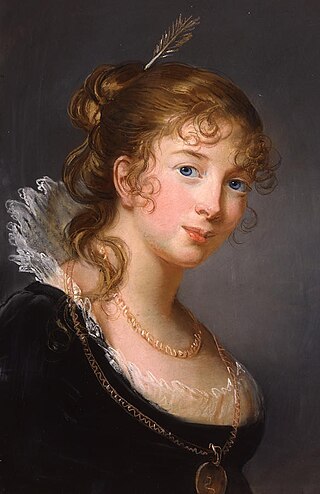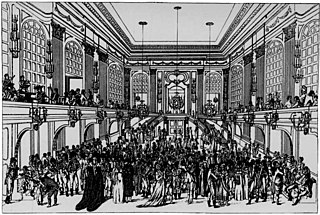
The Piano Sonata No. 11 in A major, K. 331 / 300i, by Wolfgang Amadeus Mozart is a piano sonata in three movements.
The Piano Sonata No. 16 in C major, K. 545, by Wolfgang Amadeus Mozart was described by Mozart in his own thematic catalogue as "for beginners", and it is sometimes known by the nickname Sonata facile or Sonata semplice.

Eine kleine Nachtmusik, K. 525, is a 1787 composition for a chamber ensemble by Wolfgang Amadeus Mozart (1756–1791). The German title means "a little night music". The work is written for an ensemble of two violins, viola, cello and double bass, but is often performed by string orchestras. The serenade is one of Mozart's most famous works.

The Piano Sonata No. 13 in B-flat major, K. 333 / 315c, was composed by Wolfgang Amadeus Mozart in Linz at the end of 1783.

The Kegelstatt Trio, K. 498, is a piano trio for clarinet, viola and piano in E-flat major by Wolfgang Amadeus Mozart.
The Nannerl Notenbuch, or Notenbuch für Nannerl is a book in which Leopold Mozart, from 1759 to about 1764, wrote pieces for his daughter, Maria Anna Mozart, to learn and play. His son Wolfgang also used the book, in which his earliest compositions were recorded. The book contains simple short keyboard pieces, suitable for beginners; there are many anonymous minuets, some works by Leopold, and a few works by other composers including Carl Philipp Emanuel Bach and the Austrian composer Georg Christoph Wagenseil. There are also some technical exercises, a table of intervals, and some modulating figured basses. The notebook originally contained 48 bound pages of music paper, but only 36 pages remain, with some of the missing 12 pages identified in other collections. Because of the simplicity of the pieces it contains, the book is often used to provide instruction to beginning piano players.
The String Quintet No. 4 in G minor, K. 516, written by Wolfgang Amadeus Mozart, is like all of Mozart's string quintets a "viola quintet" in that it is scored for string quartet and an extra viola . The mood of the piece is dark and melancholic, typical of Mozart's G minor works.
The Quintet in E♭ major for Piano and Winds, K. 452, was composed by Wolfgang Amadeus Mozart on March 30, 1784 and premiered two days later at the Imperial and Royal National Court Theater in Vienna. Shortly after the premiere, Mozart wrote to his father that "I myself consider it to be the best thing I have written in my life." It is scored for piano, oboe, clarinet, horn and bassoon.

Wolfgang Amadeus Mozart's Piano Sonata No. 9 in D major, K. 311 / 284c, was written on the composer's stay in Augsburg and Mannheim in November-December 1777, and is contemporaneous with his Sonata No. 7 in C Major K. 309. The three sonatas K. 309–311 were published as a set 'Opus IV' in about 1782, by Franz Joseph Heina in Paris.

The Piano Sonata No. 18 in D major, K. 576, was composed by Wolfgang Amadeus Mozart as part of a set of six for Princess Frederica Louise of Prussia in 1789. It is often nicknamed "The Hunt" or "The Trumpet Sonata", for the hornlike opening. The sonata, having a typical performance duration of about 15 minutes, is Mozart's last.

The composer Wolfgang Amadeus Mozart wrote a great deal of dance music, both for public use and as elements of larger works such as operas, quartets, and symphonies. According to the reminiscences of those who knew him, the composer himself enjoyed dancing very much; he was skillful and danced often.
Wolfgang Amadeus Mozart's first four sonatas for keyboard and violin, K. 6–9 are among his earliest works. These were composed by a budding Mozart between 1762 and 1764. They encompass several of Mozart's firsts as a composer: for example, his first works incorporating the violin, his first works with more than a single instrument, his first works in more than one movement and his first works in sonata form. In fact, previous to this, all his works had been short solo-pieces for the harpsichord.
Wolfgang Amadeus Mozart composed six sonatas for keyboard with accompaniment of violin and cello, K. 10–15, in late 1764 in London during the Mozart family's grand tour of Europe. Queen Charlotte commissioned them on 25 October, and the works were dedicated to her on 18 January 1765. They were published as Mozart's "Opus III" by his father Leopold at 20 Frith Street, Soho, London, where the Mozarts lived from September 1764 until after May 1765.
Divertimento No. 11 or Divertimento in D, K. 251, is a composition by Wolfgang Amadeus Mozart. It was written in July 1776 in Salzburg, possibly for the name day of Mozart's sister, Nannerl on July 26th or her birthday on July 30th. The work is scored for oboe, two horns, two violins, viola and double bass.
The Piano Sonata in C major, D 279, composed by Franz Schubert in September 1815, has three movements and is regarded as incomplete for lacking a fourth movement. D. 346, an unfinished Allegretto in C major, has been suggested as its final movement.
Violin Sonata No. 33 in E-flat major was composed by Wolfgang Amadeus Mozart in Vienna and listed in his personal catalogues of his works on December 12, 1785. It was published on its own by Franz Anton Hoffmeister, a German composer and music publisher to whom Mozart's String Quartet No. 20 is dedicated. The muscologist Marius Flothuis states that although much is unknown about the history of this sonata, it is certainly "one of the most mature works in Mozart's whole chamber output". Carl Friedrich Cramer in a 1783 review of this and Mozart's other mature piano and violin sonatas praised the style of composing for instruments in a democratic manner, fitting for the style, requiring skill and talent of both instrumentalists. Indeed, Manafu rates these sonatas as of crucial importance in the development of the genre.
The Symphony in F major "No. 43", K. 76/42a, was probably written by Wolfgang Amadeus Mozart.

The Symphony in A minor "Odense", K. Anh. 220/16a, was formerly attributed to Wolfgang Amadeus Mozart. If the Odense Symphony had truly been Mozart's, it would be among only three of Mozart's symphonies to be written in a minor key. It is now considered certain that the symphony is not by Mozart.
The London Sketchbook (German: Londoner Skizzenbuch), K.15 a–ss (Anh. 109b) is a series of 43 untitled pieces and sketches written by Wolfgang Amadeus Mozart between 1764 and 1765 while in London (see the Mozart family's grand tour). The set of works is denoted by its K6 number, followed by its respective letter, i.e. 15a, 15b, 15c, etc.

The Sonata in C major for piano four-hands, K. 521, is a piano sonata in three movements composed by Wolfgang Amadeus Mozart in 1787. It was his last complete piano duet sonata for one piano, four hands. This sonata consists of three movements: Allegro, Andante and Allegretto.







